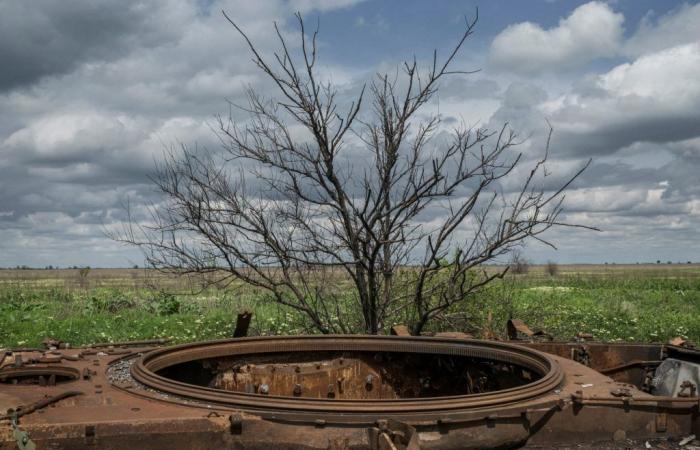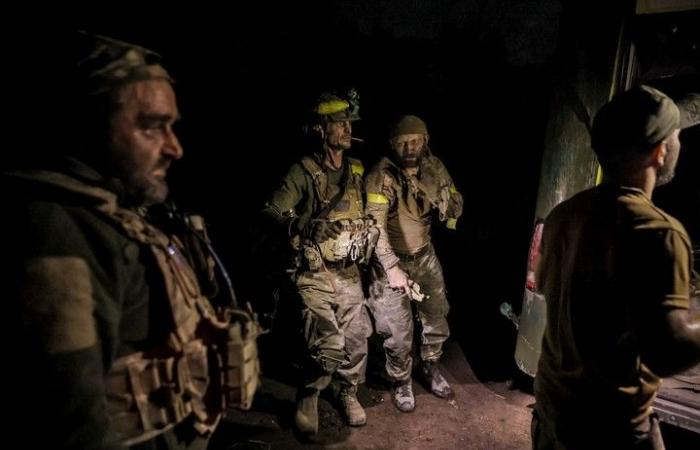WASHINGTON – May was a particularly deadly month for the Russian military in Ukraine, with an average of more than 1,000 of its soldiers wounded or killed every dayaccording to American, British and other Western intelligence agencies.
But despite its losses, Russia is recruiting 25,000 to 30,000 new troops a month, roughly as many as are leaving the battlefield, U.S. officials said.
This has allowed its army to continue sending wave after wave of troops to the Ukrainian defenses, hoping to overwhelm them and break the trench lines.
It is a style of warfare that Russian soldiers have compared to being put in a meat mincerin which commanding officers seem oblivious to the fact that they are sending infantrymen to die.
At times, this approach has proven effective and has given the Russian military victories in Avdiivka and Bakhmut, in eastern Ukraine.
But Ukrainian and Western officials say the tactics were less successful this spring when Russia tried to seize land near the town of Kharkiv.
US officials said Russia achieved a critical goal of the president Vladimir Putin:
create a buffer zone along the border to make it difficult for the Ukrainians to attack the country.
But the advance did not threaten Kharkiv and was eventually halted by Ukrainian defenses, according to Western officials.
“President Putin and Moscow have really tried to make breakthroughs, break the front lines this spring,” he said. Jens StoltenbergNATO Secretary General, in an interview with the New York Times editorial board.
“They tried and failed. They made very small profits and are paying a very high price.”
Costs
Russian casualties have increased on other occasions, notably during the attacks on Avdiivka and Bakhmut.
But the attacks on these cities spread over several months.
The May offensive, both outside Kharkiv and along the Eastern Front, involved more intense periods of waves of Russian attacks.
British military intelligence analysts said Russian casualties in May, which they estimated at an average of 1,200 per day, They were the highest of the war.
Last month’s fighting decimated the town of Vovchansk, about 40 miles from Kharkiv, where Ukrainian and Russian troops are locked in a grueling battle for control.
Russian soldiers have said in Telegramthe social network and the messaging platform, that its units are suffering a large number of casualties.
Some say their ranks are being thinned by dronesmachine gun fire and artillery bombardment.
Russia’s use of infantry in waves of attacks reflects one of its advantages in warfare:
Its population is much larger than that of Ukraine, which gives it a largest reserve of potential recruits.
But casualties have forced Russia to send new recruits to Ukraine relatively quickly, meaning soldiers sent to the front are poorly trained.
The lack of structured training and the need to commit new recruits to combat operations have limited Russia’s ability to generate more capable units.
It also increases casualties.
But it’s more complicated than that.
The changing nature of modern warfare has also increased the body count in recent months.
Ubiquitous drones have made it easier for both sides to detect and target enemy forces.
And mines and cluster munitions make movement across open terrain a almost suicidal task.
Since Putin launched a full-scale invasion in February 2022, at least 350,000 Russian soldiers have been killed or wounded, Defense Secretary Lloyd Austin said recently.
British estimates put the number of Russians killed or wounded at more than 500,000.
U.S. estimates of casualties in the war are based on satellite imagery, intercepted communications, social media and journalists’ reports in the media, as well as official reports from Russia and Ukraine.
But those estimates vary, even within the US government.
Reliable estimates of casualties in Ukraine are harder to come by.
Ukrainian officials guard these figures closely.
Several US officials insist they do not have an exact account.
President Volodymyr Zelensky Ukraine has said 31,000 Ukrainian soldiers were killed in the first two years of the war, but U.S. officials say that figure appears to underestimate Ukraine’s losses.
Russia carried out a partial mobilization in September 2022, resulting in tens of thousands of young people they will flee the country.
But Western intelligence analysts say Russia will not need to carry out another similar mobilization or recruitment this year.
Russia appears to be able to sustain its current campaign by offering financial incentives to recruits, turning to convicts and bringing in some Russian mercenaries from Africa.
But the main question for this year will be whether Russia’s current strategy can overcome the Ukrainian armed forces, which are finding their defensive footing.
The weapons and ammunition of a new US aid package 60 billion dollars They are finally reaching the front, and Ukrainian commanders no longer have to ration ammunition.
Russia still surpasses Ukraine, but not by that much.
Changes
Ukraine has changed its stance, building fortifications and laying minefields to slow the Russian advance.
War favors the defender and Ukraine is focusing on holding its lines, U.S. officials said.
“What I see is a slowing of the Russian advance and a stabilization of that particular part of the front,” Austin told reporters in Brussels this month.
“A couple of weeks ago, there was concern that we would see a significant advance by the Russians.
“I don’t think we’ll see that in the future.”
And Russia’s new buffer zone on the border near Kharkiv may be an empty achievement.
Ukraine has still been able to use longer-range U.S. weapons to attack Russia because of a Biden administration policy change that allows the Ukrainian military to use U.S. missiles to attack military targets just across the border.
U.S. officials said the change is beginning to have an impact, eliminating Russian artillery and making it difficult for Moscow to attack Kharkiv.
Balance
The result, Zelenskyy said this month, was that the Kharkiv offensive turned out to be “yet another Russian mistake.”
“The destruction of the positions and launchers of Russian terrorists by our forces, our warriors, near the border really matters,” he said.
“It’s working. Exactly as we expected.”
But despite Ukraine’s success around Kharkiv, more challenges remain.
In the coming weeks, American and Western officials expect fighting to shift again to the east and south, while Russia continues to appear willing to expend forces to make incremental gains.
c.2024 The New York Times Company



